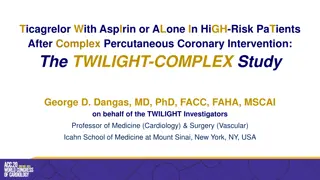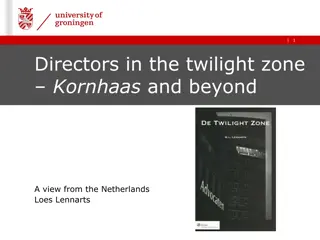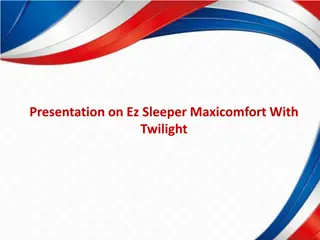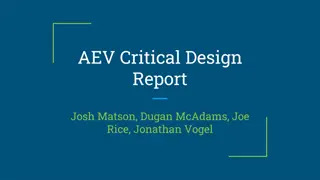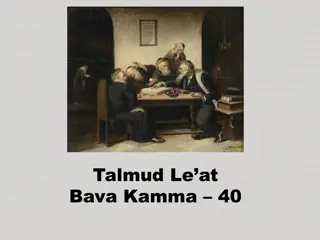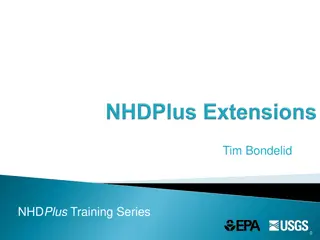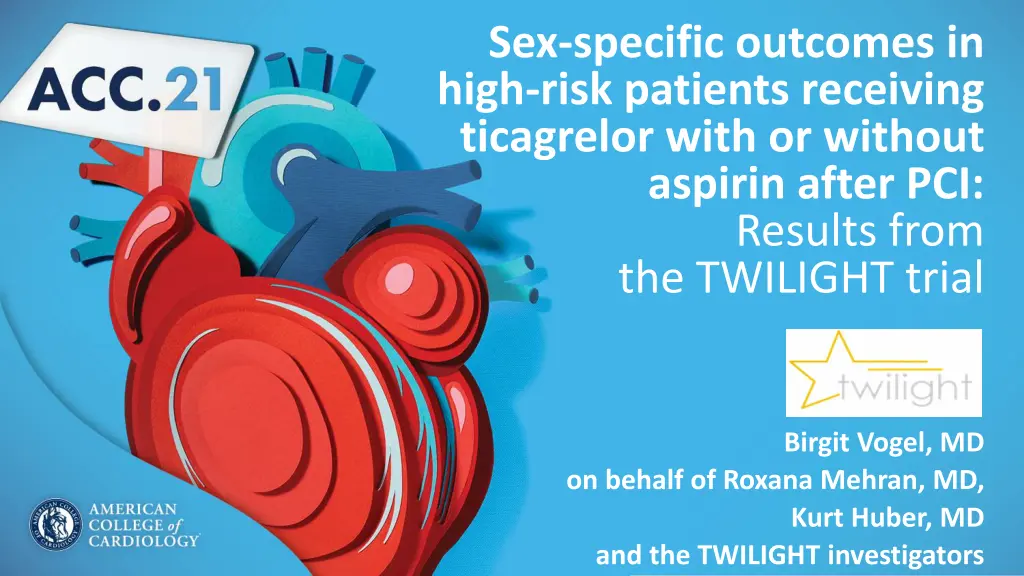
Sex-Specific Outcomes in High-Risk Patients Receiving Ticagrelor - TWILIGHT Study
Explore the sex-specific outcomes in high-risk patients undergoing PCI and receiving ticagrelor with or without aspirin based on the TWILIGHT trial. The study delves into the association of sex with outcomes, particularly bleeding risks, in patients treated with ticagrelor alone versus ticagrelor plus aspirin after PCI. The TWILIGHT trial aims to evaluate the benefits of monotherapy with a potent P2Y12 inhibitor in reducing bleeding without increasing ischemic events in high-risk patients, with a focus on potential sex differences.
Download Presentation

Please find below an Image/Link to download the presentation.
The content on the website is provided AS IS for your information and personal use only. It may not be sold, licensed, or shared on other websites without obtaining consent from the author. If you encounter any issues during the download, it is possible that the publisher has removed the file from their server.
You are allowed to download the files provided on this website for personal or commercial use, subject to the condition that they are used lawfully. All files are the property of their respective owners.
The content on the website is provided AS IS for your information and personal use only. It may not be sold, licensed, or shared on other websites without obtaining consent from the author.
E N D
Presentation Transcript
Sex-specific outcomes in high-risk patients receiving ticagrelor with or without aspirin after PCI: Results from the TWILIGHT trial Birgit Vogel, MD on behalf of Roxana Mehran, MD, Kurt Huber, MD and the TWILIGHT investigators
Disclosure statement of financial interest I, Birgit Vogel, have no conflict of interest to declare
TWILIGHT Sex Analysis: Background Compared with men, women are characterized by an increased risk for bleeding after PCI.1,2 While these associations may reflect differences in baseline risk factors (i.e. older age, renal impairment) that are more prevalent in women, other data suggest an independent biological effect of female sex on hemorrhagic risk. 1Chichareon et al, JAMA Cardiol. 2020; 2Mrdovic et al, Can J Cardiol. 2013
TWILIGHT Sex Analysis: Background The Ticagrelor With AspIrin or ALone In HiGH-Risk Patients after Coronary InTervention (TWILIGHT) study showed that monotherapy with a potent P2Y12inhibitor following a short period of dual antiplatelet therapy (DAPT) compared with continued DAPT leads to reduced bleeding without an increase in ischemic events among patients at high risk for bleeding or ischemic events after PCI.1 Whether these effects vary in relation to sex remains unknown. 1Mehran et al., N Engl J Med. 2019
TWILIGHT Sex Analysis: Objective To explore sex differences in the TWILIGHT population and to evaluate the association of sex and outcomes among patients treated with ticagrelor alone vs ticagrelor plus aspirin after PCI with implantation of DES and completion of a 3-month course of DAPT
TWILIGHT Sex Analysis: Randomized, double-blind placebo controlled trial in 187 sites and 11 countries Study Design High-risk patients underwent PCI and were treated with ticagrelor plus aspirin for 3 months Event-free and adherent patients were randomized to aspirin vs placebo and continued ticagrelor for and additional year 9006 pts enrolled (28.5% women) 852 women 2712 men Ticagrelor + Aspirin Standard of Care 7119 pts randomized (23.9% women) 846 women 2709 men Ticagrelor + Placebo Standard of Care Enrollment period 3 Months Randomization period 12 Months Observation period 3 Months 15 M 18 M 3 M
TWILIGHT Sex Analysis: Inclusion/Exclusion Criteria Must meet at least one clinical AND one angiographic criterion Clinical criteria Age 65 years Female sex Troponin-positive ACS Established vascular disease (previous MI, documented PAD or CAD/PAD revasc) DM treated with medications or insulin CKD (eGFR<60 ml/min/1.73m2 or CrCl<60 ml/min) Angiographic criteria Multivessel CAD Target lesion requiring total stent length >30 mm Thrombotic target lesion Bifurcation lesion(s) with Medina classification X, 1, 1 requiring 2 stents Left main ( 50%) or proximal LAD ( 70%) lesions Calcified target lesion(s) requiring atherectomy Key Exclusions: STEMI; Salvage PCI; need for chronic oral anticoagulation; planned coronary revascularization
TWILIGHT Sex Analysis: Methods Target Population Randomized TWILIGHT participants by sex Endpoints Primary: BARC type 2, 3, or 5 bleeding Primary ischemic: All-cause death, nonfatal MI, or nonfatal stroke between 0-12 months post randomization
TWILIGHT Sex Analysis: Methods Analytic approach Survival analyses using the Kaplan-Meier method Hazard ratios (HR) and 95% confidence intervals (CI) generated using Cox regression Models were adjusted for variables displaying baseline differences or other known biological confounders Analyses stratified by sex
TWILIGHT Sex Analysis: Patient Characteristics by Sex (I) Women Men Clinical Parameters P value (N=1698; 23.9%) 65.5 9.6 (N=5421; 76.1%) 63.4 10.3 Age, years (mean SD) <.001 Non-white race 33.7% 30.0% .004 BMI, kg/m2 (mean SD) 28.8 6.4 28.5 5.3 .12 DM 36.4% 36.9% .69 Insulin-treated DM 33.5% 25.1% <.001 CKD 21.2% 14.7% <.001 Anemia 23.2% 18.3% <.001 Current smoker 17.0% 23.3% <.001 Hypercholesterolemia 58.9% 60.9% .13 Hypertension 76.5% 71.1% <.001
TWILIGHT Sex Analysis: Patient Characteristics by Sex (I) Women Men Clinical Parameters P value (N=1698; 23.9%) 65.5 9.6 (N=5421; 76.1%) 63.4 10.3 Age, years (mean SD) <.001 Non-white race 33.7% 30.0% .004 BMI, kg/m2 (mean SD) 28.8 6.4 28.5 5.3 .12 DM 36.4% 36.9% .69 Insulin-treated DM 33.5% 25.1% <.001 CKD 21.2% 14.7% <.001 Anemia 23.2% 18.3% <.001 Current smoker 17.0% 23.3% <.001 Hypercholesterolemia 58.9% 60.9% .13 Hypertension 76.5% 71.1% <.001
TWILIGHT Sex Analysis: Patient Characteristics by Sex (II) Women Men P value Clinical Parameters (N=1698; 23.9%) 6.6% 20.9% 32.5% 6.4% 1.1% (N=5421; 76.1%) 7.0% 31.1% 45.1% 11.1% 0.8% Peripheral arterial disease Previous MI Previous PCI Previous CABG Previous major bleed Indication for PCI ACS Stable CAD .61 <.001 <.001 <.001 .24 <.001 68.4% 31.6% 63.7% 36.3%
TWILIGHT Sex Analysis: Patient Characteristics by Sex (II) Women Men P value Clinical Parameters (N=1698; 23.9%) 6.6% 20.9% 32.5% 6.4% 1.1% (N=5421; 76.1%) 7.0% 31.1% 45.1% 11.1% 0.8% Peripheral arterial disease Previous MI Previous PCI Previous CABG Previous major bleed Indication for PCI ACS Stable CAD .61 <.001 <.001 <.001 .24 <.001 68.4% 31.6% 63.7% 36.3%
TWILIGHT Sex Analysis: Patient Characteristics by Sex (III) Women Men P value Procedural Parameters (N=1698; 23.9%) 70.4% 55.4% (N=5421; 76.1%) 73.6% 65.0% Radial artery access Multivessel CAD Target vessel Left Main LAD LCX RCA Number of vessels treated (mean SD) Number of lesions treated (mean SD) .01 <.001 4.4% 60.7% 26.2% 34.9% 5.1% 54.8% 34.2% 35.2% .24 <.001 <.001 .85 1.26 0.50 1.29 0.53 .044 1.47 0.71 1.54 0.76 <.001
TWILIGHT Sex Analysis: Patient Characteristics by Sex (IV) Women Men Procedural Parameters P value (N=1698; 23.9%) (N=5421; 76.1%) Lesion morphology Moderate/severe calcification Bifurcation Total occlusion Thrombotic Total stent length, mm (mean SD) Minimum stent diameter, mm (mean SD) 14.7% 11.8% 5.4% 10.5% 37.6 22.1 2.8 0.5 13.6% 12.3% 6.5% 10.5% 40.6 24.9 2.9 0.5 .24 .58 .10 .95 <.001 <.001 Lesion morphology assessed by operators Stent length calculated by operators
TWILIGHT Sex Analysis: BARC 2, 3 or 5 Bleeding by Sex at 1 Year 10 Cumulative incidence (%) Women vs Men HR 1.32 (95% CI 1.06 1.64) P = .013 8 6.8% 6 5.2% 4 Women 2 Men 0 0 60 120 Days after randomization 180 240 300 360 Number at risk 1549 4987 Women Men 1698 5421 1663 5323 1642 5242 1621 5171 1584 5102 1567 5043
TWILIGHT Sex Analysis: Pre-specified Bleeding Endpoints by Sex 4% Women Men 1-year event rate (%) 3% P = .03 P = .06 2.1% 2.0% P = .06 2% 1.5% P = .79 1.4% 1.3% 0.9% 0.8% 1% 0.7% 0% BARC 3 or 5 TIMI major GUSTO moderate or severe ISTH major
TWILIGHT Sex Analysis: Adjusted Bleeding Outcomes by Sex Men* N=5421 Women N=1698 6.8% vs. 5.2% 1.32 (1.06 - 1.64) Adjusted Hazard Ratio (95% CI) Hazard Ratio (95% CI) P value BARC 2,3 or 5 1.20 (0.95- 1.52) .12 1.49 (0.96 - 2.32) .08 2.0% vs. 1.3% 1.57 (1.04 - 2.37) BARC 3 or 5 0.8% vs. 0.7% 1.09 (0.58 2.04) TIMI major 1.20 (0.62 - 2.31) .59 GUSTO moderate or severe 1.5% vs. 0.9% 1.60 (0.99 - 2.58) 1.57 (0.95 - 2.61) .08 2.1% vs. 1.4% 1.47 (0.99 - 2.20) 1.37 (0.89 - 2.11) .16 ISTH major 0.1 1.0 10.0 Women at higher risk Men at higher risk Bleeding outcomes were evaluated in the intention-to-treat cohort *reference, Model adjusted for age (years), nonwhite race, region of enrollment, insulin-treated diabetes, CKD, anemia, current smoker, hypertension, previous MI, previous coronary revascularization (previous PCI or CABG), multivessel CAD, indication for PCI, radial artery access, whether LAD was treated, whether LCX was treated, number of lesions treated, and minimum stent diameter (mm).
TWILIGHT Sex Analysis: Death, MI or stroke by Sex at 1 Year 10 Cumulative incidence (%) 8 Women vs. Men HR 0.86 (95% CI 0.65 1.15) P = .32 6 4.0% 4 Women 3.5% 2 Men 0 120 Days after randomization 180 240 300 360 0 60 Number at risk 1635 5199 1644 5246 1614 5143 1605 5106 1596 5057 1676 5363 1656 5293 Women Men
TWILIGHT Sex Analysis: Pre-specified Ischemic Endpoints by Sex 6% Women Men 1-year event rate % 5% P = .30 3.8% 4% P = .45 3.2% 2.8% 3% 2.5% P = .31 2% P = .23 1.2% P = .55 P = .44 1.0% 0.9% 1% 0.7% 0.5% 0.4% 0.4% 0.3% 0% CV death, MI or ischemic stroke All-cause death CV death MI Ischemic stroke Stent thrombosis (definite/probable)
TWILIGHT Sex Analysis: Adjusted Ischemic Outcomes by Sex Men* N=5363 Hazard Ratio (95% CI) Women N=1676 3.5% vs 4.0% 0.86 (0.65-1.15) Adjusted Hazard Ratio (95% CI) P value Death, MI or stroke 0.87 (0.64-1.18) .36 CV death, MI or ischemic stroke all-cause death 3.2% vs 3.8% 0.85 (0.63-1.15) 0.85 (0.62-1.17) .32 0.9% vs 1.2% 0.75 (0.43-1.31) 0.64 (0.35-1.15) .14 0.55 (0.27-1.09) .09 0.7% vs 1.0% 0.67 (0.35-1.29) CV death 2.5% vs 2.8% 0.88 (0.62-1.24) 0.93 (0.64-1.33) .68 MI Ischemic stroke 0.4% vs 0.3% 1.31 (0.54-3.17) 0.94 (0.38-2.35) .90 Stent thrombosis (definite or probable) 0.4% vs 0.5% 0.71 (0.29-1.71) 0.72 (0.29-1.78) .47 0.1 1.0 10.0 Men at higher risk Women at higher risk Ischemic outcomes were evaluated in the per-protocol cohort *reference, Model adjusted for age (years), nonwhite race, region of enrollment, insulin-treated diabetes, CKD, anemia, current smoker, hypertension, previous MI, previous coronary revascularization (previous PCI or CABG), multivessel CAD, indication for PCI, radial artery access, whether LAD was treated, whether LCX was treated, number of lesions treated, and minimum stent diameter (mm).
TWILIGHT Sex Analysis: BARC 2, 3 or 5 Bleeding by Sex and Randomized Treatment Ticagrelor +placebo Ticagrelor +aspirin* Adjusted hazard ratio (95% CI) Interaction P value P value Women 42 (5.0%) 72 (8.6%) 0.62 (0.42 - 0.92) 0.018 0.69 Men 99 (3.7%) 178 (6.6%) 0.57 (0.44 - 0.73) <.001 8.6% 6.6% 5.0% 3.7% Women: Ticagrelor + Aspirin Women: Ticagrelor + Placebo Men: Ticagrelor + Aspirin Men: Ticagrelor + Placebo *reference Model adjusted for age (years), non-white race, region of enrollment, insulin- treated diabetes, CKD, current smoking, hypercholesterolemia, previous PCI, multivessel CAD, indication for PCI, lesion calcification.
TWILIGHT Sex Analysis: Pre-specified Bleeding Endpoints by Sex and Randomized Treatment Ticagrelor +placebo N (%) N (%) Ticagrelor +aspirin* Adjusted Hazard Ratio (95% CI) 0.78 (0.39 - 1.58) .49 0.42 (0.25 - 0.71) .001 Interaction P value P value 14 (1.7) vs 20 (2.4) 20 (0.8) vs 49 (1.8) BARC 3 or 5 .18 3 (0.4) vs 10 (1.2) 14 (0.5) vs 24 (0.9) 0.31 (0.09 - 1.15) .08 0.62 (0.32 - 1.21) .16 TIMI major .34 0.59 (0.26 - 1.34) .21 0.53 (0.29 - 0.95) .03 9 (1.1) vs 16 (1.9) 17 (0.6) vs 33 (1.2) GUSTO moderate or severe .85 15 (1.8) vs 20 (2.4) 24 (0.9) vs 52 (1.9) 0.78 (0.39 - 1.58) .49 0.48 (0.29 - 0.77) .003 .26 ISTH major 0.1 1.0 10.0 Tica+aspirin lower risk Tica+placebo lower risk Bleeding outcomes were evaluated in the intention-to-treat cohort *reference, Model adjusted for age (years), non-white race, region of enrollment, insulin-treated diabetes, CKD, current smoking, hypercholesterolemia, previous PCI, multivessel CAD, indication for PCI, lesion calcification.
TWILIGHT Sex Analysis: Death, MI, or Stroke by Sex and Randomized Treatment Ticagrelor +Placebo Ticagrelor +Aspirin* Adjusted hazard ratio (95% CI) Interaction P value P value Women 29 (3.5%) 29 (3.5%) 1.04 (0.61 1.77) 0.88 0.95 Men 106 (4.0%) 108 (4.1%) 1.06 (0.80 - 1.39) 0.69 4.1% 4.0% 3.5% 3.5% Women: Ticagrelor + Aspirin Women: Ticagrelor + Placebo Men: Ticagrelor + Aspirin Men: Ticagrelor + Placebo *reference Model adjusted for age (years), non-white race, region of enrollment, insulin-treated diabetes, CKD, current smoking, hypercholesterolemia, previous PCI, multivessel CAD, indication for PCI, lesion calcification.
TWILIGHT Sex Analysis: Pre-specified Ischemic Endpoints by Sex and Randomized Treatment Ticagrelor +placebo N (%) N (%) Adjusted Hazard Ratio (95% CI) Ticagrelor +aspirin* Interaction P value P value CV death, MI or ischemic stroke 27 (3.2) vs 27 (3.3) 99 (3.7) vs 103 (3.9) 1.06 (0.61 - 1.84) .84 1.03 (0.78 - 1.36) .85 >.99 0.17 (0.04 - 0.78) .022 1.00 (0.61 - 1.64) >.99 0.12 (0.02 - 0.97) .046 0.89 (0.51 - 1.54) .68 3 (0.4) vs 12 (1.4) 31 (1.2) vs 33 (1.2) All-cause death .03 2 (0.2) vs 9 (1.1) 24 (0.9) vs 28 (1.1) CV death .07 21 (2.5) vs 20 (2.4) 74 (2.8) vs 75 (2.8) 1.14 (0.60 - 2.15) .69 1.07 (0.77 - 1.49) .68 MI .98 5 (0.6) vs 2 (0.2) 11 (0.4) vs 6 (0.2) 2.15 (0.41 - 11.3) .36 1.87 (0.69 - 5.06) .22 Ischemic stroke .66 2 (0.2) vs 4 (0.5) 12 (0.5) vs 15 (0.6) 0.58 (0.10 - 3.29) .54 0.83 (0.39 - 1.77) .62 Stent thrombosis (definite or probable) .67 0.01 0.1 1 10 100 Tica+aspirin lower risk Tica+placebo lower risk Ischemic outcomes were evaluated in the per-protocol cohort *reference, Model adjusted for age (years), non-white race, region of enrollment, insulin-treated diabetes, CKD, current smoking, hypercholesterolemia, previous PCI, multivessel CAD, indication for PCI, lesion calcification.
TWILIGHT Sex Analysis: BARC 2, 3, or 5 Bleeding: Absolute Risk Reduction Women (N=1698) Men (N=5421) - 3.6% 8.6% - 2.9% 10% BARC 2, 3, or 5 bleeding (%) 6.6% 5.0% 3.7% 5% 0% Ticagrelor + placebo Ticagrelor + aspirin
TWILIGHT Sex Analysis: Limitations Neither of the sex-specific subgroups were individually powered to draw definitive conclusions on effect of ticagrelor monotherapy vs ticagrelor plus aspirin on outcome. Randomization was not stratified by sex. Findings are specific to a PCI population at high risk for bleeding or ischemic events. Our analyses considered only patients who tolerated an initial 3 months of DAPT with ticagrelor plus aspirin without any major adverse events.
TWILIGHT Sex Analysis: Conclusions Women had a higher bleeding risk compared with men, which was mostly attributable to baseline differences. Ischemic events were similar between sexes. In this high-risk PCI population, the benefits of early aspirin withdrawal with continuation of ticagrelor were generally comparable in women and men. Our findings should motivate dedicated studies to further explore the benefits of early aspirin withdrawal in women.
We thank all country leaders, investigators, coordinators and study participants who made TWILIGHT possible!






